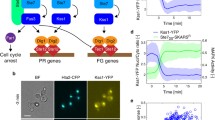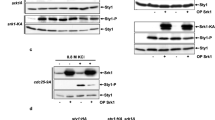Abstract
The activity of protein phosphatases on mitogen-activated protein kinases (MAPKS) is essential in the modulation of the final outcome of MAPK-signalling pathways. The yeast dual-specificity phosphatase (DSP) Msg5, expressed as two isoforms of different length, dephosphorylates the MAPKs of mating and cell integrity pathways, Fus3 and Slt2, respectively, but its action on the MAPK Kss1 is unclear. Here we analyse the global impact of Msg5 on the yeast transcriptome. Both Fus3- and Slt2- but not Kss1-mediated gene expression is induced in cells lacking Msg5. However, although these cells show high Slt2 phosphorylation, the Rlm1-dependent Slt2-regulated transcriptional response is weak. Therefore, mechanisms concomitant with Slt2 phosphorylation are required for a strong Rlm1 activation. The limited Slt2 activity on Rlm1 is not a specific effect on this substrate but a consequence of its low kinase activity in msg5Δ cells. Lack of Msg5 does not increase Kss1 phosphorylation although both proteins physically interact. Both Msg5 isoforms interact similarly with Slt2, whereas the long form binds Fus3 with higher affinity and consequently down-regulates it more efficiently than the short one. We propose that specific binding of DSP isoforms to distinct MAPKs provides a novel mechanism for fine tuning different pathways by the same phosphatase.






Similar content being viewed by others
References
Andersson J, Simpson DM, Qi M, Wang Y, Elion EA (2004) Differential input by Ste5 scaffold and Msg5 phosphatase route a MAPK cascade to multiple outcomes. EMBO J 23:2564–2576
Bardwell L, Cook JG, Inouye CJ, Thorner J (1994) Signal propagation and regulation in the mating pheromone response pathway of the yeast Saccharomyces cerevisiae. Dev Biol 166:363–379
Bermejo C, Rodríguez E, García R, Rodríguez-Peña JM, Rodríguez de la Concepción ML, Rivas C, Arias P, Nombela C, Posas F, Arroyo J (2008) The sequential activation of the yeast HOG and SLT2 pathways is required for cell survival to cell wall stress. Mol Biol Cell 19:1113–1124
Cabib E, Blanco N, Grau C, Rodriguez-Peña JM, Arroyo J (2007) Crh1p and Crh2p are required for the cross-linking of chitin to beta(1-6)glucan in the Saccharomyces cerevisiae cell wall. Mol Microbiol 63:921–935
Carmona-Saez P, Chagoyen M, Tirado F, Carazo JM, Pascual-Montano A (2007) GENECODIS: a web-based tool for finding significant concurrent annotations in gene lists. Genome Biol 8:R3
Chen RE, Thorner J (2007) Function and regulation in MAPK signaling pathways: Lessons learned from the yeast Saccharomyces cerevisiae. Biochim Biophys Acta 1773:1311–1340
Chirivi RG, Dilaver G, van de Vorstenbosch R, Wanschers B, Schepens J, Croes H, Fransen J, Hendriks W (2004) Characterization of multiple transcripts and isoforms derived from the mouse protein tyrosine phosphatase gene Ptprr. Genes Cells 9:919–933
Cullen PJ, Schultz J, Horecka J, Stevenson BJ, Jigami Y, Sprague GF Jr (2000) Defects in protein glycosylation cause SHO1-dependent activation of a STE12 signaling pathway in yeast. Genetics 155:1005–1018
Cullen PJ, Sabbagh W Jr, Graham E, Irick MM, van Olden EK, Neal C, Delrow J, Bardwell L, Sprague GF Jr (2004) A signaling mucin at the head of the Cdc42- and MAPK-dependent filamentous growth pathway in yeast. Genes Dev 18:1695–1708
Davenport KD, Williams KE, Ullmann BD, Gustin MC (1999) Defects in protein glycosylation cause SHO1-dependent activation of a STE12 signaling pathway in yeast. Genetics 153:1091–1103
Doi K, Gartner A, Ammerer G, Errede B, Shinkawa H, Sugimoto K, Matsumoto K (1994) MSG5, a novel protein phosphatase promotes adaptation to pheromone response in S. cerevisiae. EMBO J 13:61–70
Elion EA, Brill JA, Fink GR (1991) FUS3 represses CLN1 and CLN2 and in concert with KSS1 promotes signal transduction. Proc Natl Acad Sci USA 88:9392–9396
Flandez M, Cosano IC, Nombela C, Martin H, Molina M (2004) Reciprocal regulation between Slt2 MAPK and isoforms of Msg5 dual-specificity protein phosphatase modulates the yeast cell integrity pathway. J Biol Chem 279:11027–11034
García R, Bermejo C, Grau C, Perez R, Rodriguez-Peña JM, Francois J, Nombela C, Arroyo J (2004) The global transcriptional response to transient cell wall damage in Saccharomyces cerevisiae and its regulation by the cell integrity signaling pathway. J Biol Chem 279:15183–15195
Jiménez-Sánchez M, Cid VJ, Molina M (2007) Retrophosphorylation of Mkk1 and Mkk2 MAPKKs by the Slt2 MAPK in the yeast cell integrity pathway. J Biol Chem 282:31174–31185
Jung US, Levin DE (1999) Genome-wide analysis of gene expression regulated by the yeast cell wall integrity signalling pathway. Mol Microbiol 34:1049–1057
Jung US, Sobering AK, Romeo MJ, Levin DE (2002) Genome-wide analysis of gene expression regulated by the yeast cell wall integrity signalling pathway. Mol Microbiol 46:781–789
Keyse SM (2000) Protein phosphatases and the regulation of mitogen-activated protein kinase signalling. Curr Opin Cell Biol 12:186–192
Kuranda K, Leberre V, Sokol S, Palamarczyk G, François J (2006) Investigating the caffeine effects in the yeast Saccharomyces cerevisiae brings new insights into the connection between TOR, PKC and Ras/cAMP signalling pathways. Mol Microbiol 61:1147–1166
Lee BN, Elion EA (1999) The MAPKKK Ste11 regulates vegetative growth through a kinase cascade of shared signaling components. Proc Natl Acad Sci USA 96:12679–12684
Levin DE (2005) Cell wall integrity signaling in Saccharomyces cerevisiae. Microbiol Mol Biol Rev 69:262–291
Lewis TS, Shapiro PS, Ahn NG (1998) Signal transduction through MAP kinase cascades. Adv Cancer Res 74:49–139
Livak KJ, Schmittgen TD (2001) Analysis of relative gene expression data using real-time quantitative PCR and the 2(-Delta Delta C(T)) method. Methods 25:402–408
Madhani HD, Styles CA, Fink GR (1997) MAP kinases with distinct inhibitory functions impart signaling specificity during yeast differentiation. Cell 91:673–684
Madhani HD, Galitski T, Lander ES, Fink GR (1999) Effectors of a developmental mitogen-activated protein kinase cascade revealed by expression signatures of signaling mutants. Proc Natl Acad Sci USA 96:12530–12535
Martín H, Rodriguez-Pachon JM, Ruiz C, Nombela C, Molina M (2000) Regulatory mechanisms for modulation of signaling through the cell integrity Slt2-mediated pathway in Saccharomyces cerevisiae. J Biol Chem 275:1511–1519
Martín H, Flandez M, Nombela C, Molina M (2005) Protein phosphatases in MAPK signalling: we keep learning from yeast. Mol Microbiol 58:6–16
Martin-Yken H, Dagkessamanskaia A, Basmaji F, Lagorce A, Francois J (2003) The interaction of Slt2 MAP kinase with Knr4 is necessary for signalling through the cell wall integrity pathway in Saccharomyces cerevisiae. Mol Microbiol 49:23–35
Mitchell DA, Marshall TK, Deschenes RJ (1993) Vectors for the inducible overexpression of glutathione S-transferase fusion proteins in yeast. Yeast 9:715–722
Qi M, Elion EA (2005) MAP kinase pathways. J Cell Sci 118:3569–3572
Remenyi A, Good MC, Bhattacharyya RP, Lim WA (2005) The role of docking interactions in mediating signaling input, output, and discrimination in the yeast MAPK network. Mol Cell 20:951–962
Roberts CJ, Nelson B, Marton MJ, Stoughton R, Meyer MR, Bennett HA, He YD, Dai H, Walker WL, Hughes TR, Tyers M, Boone C, Friend SH (2000) Signaling and circuitry of multiple MAPK pathways revealed by a matrix of global gene expression profiles. Science 287:873–880
Rodríguez-Pachón JM, Martín H, North G, Rotger R, Nombela C, Molina M (2002) A novel connection between the yeast Cdc42 GTPase and the Slt2-mediated cell integrity pathway identified through the effect of secreted Salmonella GTPase modulators. J Biol Chem 277:27094–27102
Ruiz C, Escribano MV, Morgado E, Molina M, Mazón MJ (2003) Cell type-dependent repression of yeast a-specific genes requires Itc1p, a subunit of the Isw2p-Itc1p chromatin remodelling complex. Microbiology 149:341–351
Sabbagh W Jr, Flatauer LJ, Bardwell AJ, Bardwell L (2001) Specificity of MAP kinase signaling in yeast differentiation involves transient versus sustained MAPK activation. Mol Cell 8:683–691
Saeed AI, Sharov V, White J, Li J, Liang W, Bhagabati N, Braisted J, Klapa M, Currier T, Thiagarajan M, Sturn A, Snuffin M, Rezantsev A, Popov D, Ryltsov A, Kostukovich E, Borisovsky I, Liu Z, Vinsavich A, Trush V, Quackenbush J (2003) TM4: a free, open-source system for microarray data management and analysis. Biotechniques 34:374–378
Schwartz MA, Madhani HD (2004) Principles of MAP kinase signaling specificity in Saccharomyces cerevisiae. Annu Rev Genet 38:725–748
Sherman F (1991) Getting started with yeast. Meth Enzymol 194:3–21
Straede A, Corran A, Bundy J, Heinisch JJ (2007) The effect of tea tree oil and antifungal agents on a reporter for yeast cell integrity signalling. Yeast 24:321–334
Wang Y, Dohlman HG (2004) Pheromone signaling mechanisms in yeast: a prototypical sex machine. Science 306:1508–1509
Watanabe Y, Takaesu G, Hagiwara M, Irie K, Matsumoto K (1997) Characterization of a serum response factor-like protein in Saccharomyces cerevisiae, Rlm1, which has transcriptional activity regulated by the Mpk1 (Slt2) mitogen-activated protein kinase pathway. Mol Cell Biol 17:2615–2623
Zhan XL, Deschenes RJ, Guan KL (1997) Differential regulation of FUS3 MAP kinase by tyrosine-specific phosphatases PTP2/PTP3 and dual-specificity phosphatase MSG5 in Saccharomyces cerevisiae. Genes Dev 11:1690–1702
Terrance K, Lipke PN (1987) Pheromone signaling mechanisms in yeast: a prototypical sex machine. J Bacteriol 169:4811–4815
Acknowledgments
We thank José Manuel Rodríguez-Peña, Victor J. Cid, María Jiménez-Sánchez, Raul García and Miguel Ángel Rodríguez-Gabriel for their helpful comments and reagents. We also thank M.I. García-Sáez, Rosa Pérez and Pedro Botías from Centro de Genómica y Proteómica de la Universidad Complutense/Parque Científico de Madrid (Spain) for DNA sequencing, Q-RT-PCR and microarray data analysis. This work was supported by grant BIO2007-67299 from Ministerio de Educación y Ciencia (Spain) and S-SAL-0246-2006 from Comunidad Autónoma de Madrid to M. Molina. M.J.M. is recipient of a FPU fellowship from Ministerio de Educación y Ciencia (Spain) and C.B. of a fellowship of the Universidad Complutense de Madrid (Spain).
Author information
Authors and Affiliations
Corresponding author
Additional information
Communicated by S. Hohmann.
M. J. Marín and M. Flández contributed equally to this work.
Rights and permissions
About this article
Cite this article
Marín, M.J., Flández, M., Bermejo, C. et al. Different modulation of the outputs of yeast MAPK-mediated pathways by distinct stimuli and isoforms of the dual-specificity phosphatase Msg5. Mol Genet Genomics 281, 345–359 (2009). https://doi.org/10.1007/s00438-008-0415-5
Received:
Accepted:
Published:
Issue Date:
DOI: https://doi.org/10.1007/s00438-008-0415-5




